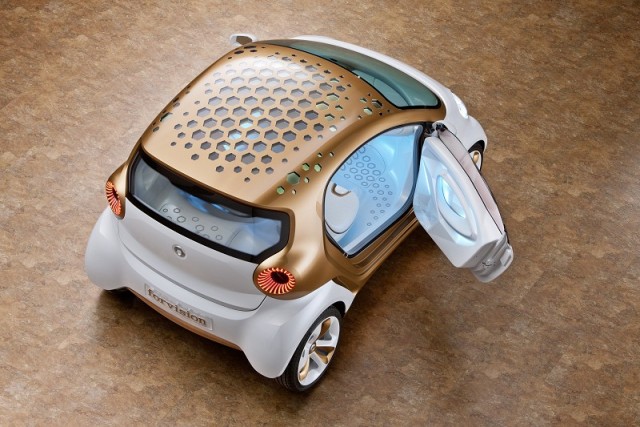"I can see you're smiling," says Annette Winkler, head of smart, as she walks us around the new forvision. We're in a studio a few miles from Stuttgart airport having an exclusive sneak peak at smart's new concept car. Called forvision, it's not only a nod to the firm's future styling direction, but also an interesting insight into future technology that should enhance the drive towards electric mobility.
I am smiling, the smart's integration of clever new technology and innovative design making it impossible not to. Sure, the overall shape's familiar, the compact two-seat, two-door profile one that you'll see parked (sometimes sideways) on many an urban street, but the detailing in the concept is different. Very different.
Everything from the wheels it rolls on to its paint finish has been re-thought in a bid to maximise efficiency. Three key facets underpin the forvision: energy efficiency, temperature management and weight reduction. All are intertwined creating efficiencies that allow the forvision to achieve the maximum range from its electric drivetrain.
It's the wheels that initially wow, not because they look special, but because of what they're constructed from. They're plastic, and a first, created - along with many of the technologies debuting here - by chemical and plastics giant BASF. They're 3kg a wheel lighter, which adding in a 1.5x factor for unsprung weight actually equates to around 18kg. That's not just to the benefit of rotational and overall mass reduction, but should also improve ride quality markedly - something current smarts could do with...
As Winkler says, smart has always been at the forefront of plastic use, with the current fortwo's body built from the material. All except the tridion safety cell, which is made from steel. On the forvision it's a carbon fibre material, with a new resin that cures in just three (rather than the more usual 15) minutes. Lighter than and just as strong as the steel cell it replaces it's one of a number of weight-saving technologies that features. The seats, again created from plastic, are lighter too, their heating elements printed and located at key points on the seat to maximise heat transmission to the person in the seat.
Along with weight reduction, heat management is key to the forvision's efficiency gains. Thin insulation foam helps keep the car warm or cool and lessens the need for power draw for air conditioning or heating systems. Reflective paint keeps the body cooler, lessening heat soak, while reflective glass also manages temperature. Solar elements in the car's roof - using a new organic dye photovoltaic cell, which is transparent - power an internal fan that vents through the rear lights. Providing power, they allow a transparent roof, which can also be additionally lit by organic LEDs at night. It's a neat styling touch, which also fits in with the forvision's quest for efficiency.
In all it's a holistic approach, which allows an increased range from the forvision's batteries of around 20% over a conventional generation III electric smart. Some of the technologies are still at the 'science stage' according to the people at BASF, but the plastic wheels could reach production in a few years, as could the reflective paint, while the transparent, organic photovoltaic cells could reach us by the next smart car's replacement. Winkler says smart was perhaps a bit too early in the marketplace when it initially launched, but now she says it's turning that into an advantage. If the company can deliver on the forvision's promise, then smart's future could be very bright indeed.

